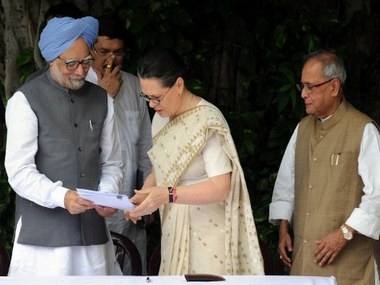The flamboyantly moustachioed columnist Thomas Friedman once famously said (only half in jest) that in this world there were only two superpowers: the United States and the rating agency Moody’s. The US, he said, could destroy you by dropping bombs. And Moody’s could destroy you by downgrading your bonds.
It’s fair to say that in the years gone by, and particularly after the 2008 financial crisis, the destructive firepower of both an economically enfeebled US (which is scaling down its military might) and of rating agencies (which were complicit in the fancy fandango that led up to the crisis) has vastly diminished.
Yet, it would be folly to overlook the stark message delivered by rating agencies on the colossal mess that passes for economic management in India.
[caption id=“attachment_282260” align=“alignright” width=“380” caption=“Lead, or get out of the way. AFP”]
 [/caption]
[/caption]
The rating agency Standard & Poor’s on Wednesday lowered its outlook on India’s sovereign rating, citing deteriorating macro fundamentals which, if left unaddressed, could result in a sovereign rating downgrade over the next two years. The reasons that the agency cited are sufficiently well known; commentators at home, including on Firstpost, have raised the red flag for a long while now. And international money managers have been voting with their feet. The fleeting flirtation with the ‘India growth story’ has given way to a ’take-your-money-and-run’ panic attack.
Yet, a government that has presided over monumental corruption and is today gripped by such a severe affliction that it won’t make even the feeblest attempt at reforms, has become borderline reckless and overly dismissive of well-intended articulations of concern.
Even one so self-effacing as Prime Minister Manmohan Singh has criticised industry leaders for their “negative comments” on government policies, when in fact he ought to have taken the constructive criticism in the spirit in which it was meant.
Which is why it needed an external voice, of a ‘superpower that can destroy without dropping bombs’, for a thick-skinned government to even begin to acknowledge that a 1991-style economic crisis is in the making.
If S&P’s warning did not bestir the government, yet more criticism came its way from another source. Glenn Levine, senior economist at Moody’s Analytics, was even more pointed, going so far as to make extraordinarily candid observations about where the real problem lies in India.
“The single biggest factor weighing on the outlook is the Indian government,“observed Levine. The UPA government, weighed down by corruption scandals, has “lost all momentum” - and no progress is likely on the reforms front between now and the next elections in 2014.
Levine then noted that the “real power behind the government, the Gandhi family” had blown its chance after the losses in the recent round of State Assembly elections. “Family scion Rahul Gandhi invested countless hours and money touring the rural backwaters of Uttar Pradesh… (but) his Congress party was drubbed…. Gandhi has barely been heard from since then.”
Manmohan Singh, adds Levine, “is an ageing technocrat who now appears tired of the rough and tumble of Indian politics. This leaves the… reform process in limbo.”
The UPA, reckons Levine, doesn’t have the numbers or the leaders to push through tough-minded reforms needed to drive the next wave of growth. “Worse still, populism is now the main factor driving policy formation, as illustrated by the recent budget, which contained various investor-damaging proposals… The budget appeared designed solely to pass through an obstinate parliament with a minimum of fuss. This is no way to run a government.”
It is hard to tell if this is a government or a demolition squad out to wreck the economy. With its reckless wielding of the tax bludgeon, it has managed to scare away even the faint revival of interest that foreign institutional investors exhibited in the Indian markets earlier this year. From $5 billion in February, FII inflow has now begun to reverse: so far in April, there has been an outflow of about $25 million. Even foreign direct investment is drying up.
The government cites the compulsions of managing a disparate coalition as the reason for its inability to deliver on reform measures. But as commentator Sadanand Dhume observes in The Wall Street Journal , the real problem runs deeper. “Simply put, India is ruled by a group of leaders whose political instincts were shaped by the notorious license-permit Raj. Under it, bureaucrats penalized companies for being too productive, and the highest marginal income tax rate touched 97.5%.”
Finance Minister Pranab Mukherjee’s muscular exertions to mop up taxes with retrospective effect - and similar policy follies in other areas - are, says Dhume, a manifestation of the “government-knows-best” mentality.
But as Moody’s Analytics’ economist Levine points out, today the government is the biggest drag on the economy. And now, the warning bells are being sounded. If the UPA cannot lead, if it cannot summon up the courage and the will to govern, it should get out of the way. The country is paying an enormous opportunity cost for every single day of policy paralysis and governmental inaction. We can no longer afford a government of bench-warmers and time-markers. And even if we could afford it, this country deserve better.
Venky Vembu attained his first Fifteen Minutes of Fame in 1984, on the threshold of his career, when paparazzi pictures of him with Maneka Gandhi were splashed in the world media under the mischievous tag ‘International Affairs’. But that’s a story he’s saving up for his memoirs… Over 25 years, Venky worked in The Indian Express, Frontline newsmagazine, Outlook Money and DNA, before joining FirstPost ahead of its launch. Additionally, he has been published, at various times, in, among other publications, The Times of India, Hindustan Times, Outlook, and Outlook Traveller.
)